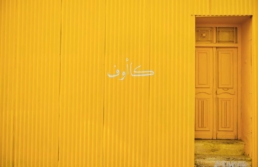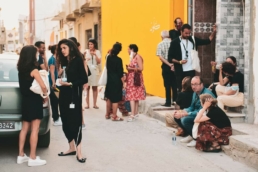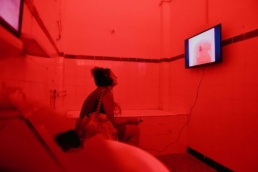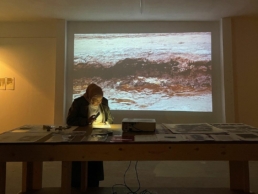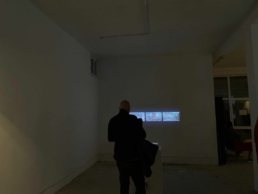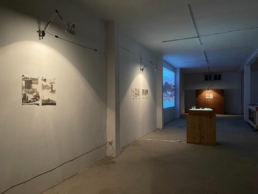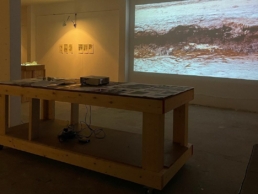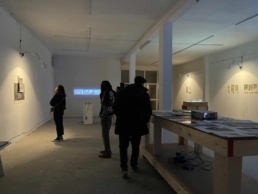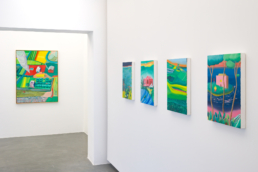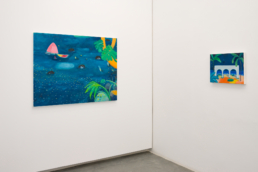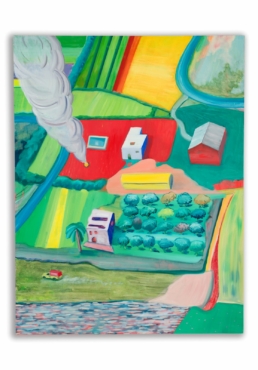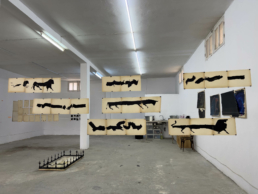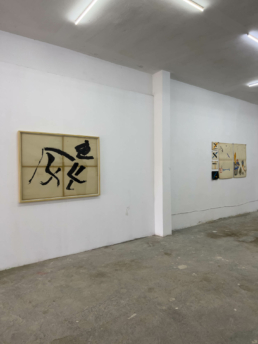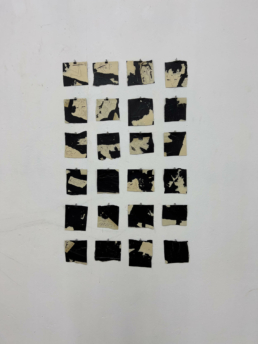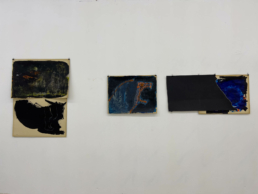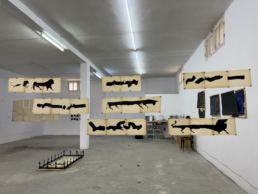KOFF
Curatorial
KOFF
The new Video Art section, K OFF is dedicated to young Tunisian artists, located in the downtown of Gabes as a linking point between el Kazma and Agora. This exhibition consists of a heuristic research of the moving image, highlighting the video as a medium, a material of creation, reflection and criticism. Reflecting on its limits; is it a succession of images? Still or in movement? Is it the device of display that defines it? Or the process of its creation? Is it a dialogue between the sound and the image? or the reflection of the space of its genesis?
This relationship to the image that each artist entertains with the video, as denotative as it may seem, is fundamental to understanding the process that it has undergone. Declined in different possibilities by the artists, it is not limited to what is perceived, but to what it represents for each one of them. It takes the shape of a drawing, a sound, a journey, a memory or a criticism. As ambiguous as it is, it is defined by the process and the context of its genesis.
Exploring video in its raw, metaphorical, experimental and sound state, it offers a crossover of an aesthetic that evolves from an itinerant approach dealing with the being and becoming of words, identity, the intuitive and a reflection of a socio-cultural reality. As complex as the sphere in which it emerges, the artists featured on the K OFF have found in the image and more specifically, the moving image a field of experimentation and exploration mixing different media and visual techniques.
The approaches and the processes they crossed are diverse. Starting from experiencing the text; for Ahmed Ben nessib “to work from the text”, means for him to do everything to exceed it. From a back and forth between the illustration and the tale of Isaac, the artist sets up a technique that he defines as “the technique of the swimmer”; which implies to rewrite the words in dichotomy. Drawing by drawing, he animates them letting what it precedes and what it succeeds in reach. He explores the animation to define one that does not lie in between the drawings but in the drawing itself. Investigating this fragmented process between the word, the drawing and the animation, Ben Nessib questions their literal definitions and ends up creating his own.
The text has, also, accompanied Rim Harrabi, in dealing with the experience of the vanity of Galway Kinnell’s poem in her imagination. Its experimental representation is located in the knots that the poem presents, it stages the latency of the characters in a bewitching atmosphere, to the extent of chimera. Stated in prose from the adult to his child and translated by Harrabi into an audiovisual installation.
As for the work of Cheb Terro, it is a process that turned into a tribute to an artist of the underground hip hop scene in Tunisia. An installation that reflects the movement he created “Toxic Club” and the polyphony of his writing. In this context, will the video clips he creates serve as vectors of transmission by the nature of their proximity to the young public? Will they serve as an archive for the critical outline of a socio-cultural space that he describes as a “sub-planet”?
To define these dimensions or to record a space, Asma Laajimi traces a memory of her childhood and a place that is getting altered. With an observant and at the same time passive glance, she walks along the urban space deprived of its seasonal dynamics, vowed to a decisional power of an inert government. From an absurd image on her happy steps, she documents this space that cradled her summer routine and that is now disintegrating. A present outline that reflects the urban context of Gabes.
The space serves, in fact, as a medium for Ghassen Chraifa. With an intuitive gaze, his daily life is provided with aesthetic gaps that accompany him in different temporalities. He records moments of stillness or mouvements in visual frames like a road journal.
For Dora Dalila Cheffi, her understanding of the space extends from the geographical construction, towards a link to her identity and herself. She unravels the relationship of her mixed roots into an ode to identity through an interpretation of the Finnish national anthem in Tabbel Kerkennah, visually accompanied by forms of contrasting colors that interact in a tryptic installation. From these poetically assembled forms, she attempts to achieve a balance between her plural identity, heritage, language and music.
KOFF is in a sense a space of reception, leading to the visual perception of these multi-layered realities, lived and experienced by the artists. The transcripts of how it influenced their aesthetic expression, displaying their point of intersection around their approaches. The audience will navigate between six distinct experiences between several visual, digital, raw or edited mediums having their contexts defined as an anchor point.
Ghassen Chraifa - Open studio
Curatorial
Ghassen ChraifaOpen studio
In residence at L’Atelier since February, Ghassen Chraifa continues to develop his research started at Résidence K in Gabes, surrounding the archives, ecosystem, and toxic environment of the coastal city. He navigates between the still and moving image, exploring different mediums such as transfer.
Tumadhir's walk - Nicène Kossentini and Alia Sellami
Tumadhir's walk - Nicène Kossentini and Alia Sellami5 DECEMBER 2022 - 21 JANUARY 2023
Elusive, were the words of Al-Khansa. This faculty that the language had to recompose itself and in its genius, as a kind of tormented wildness where the words escaped each time the meaning and the perceived. There was thus ” a movement of nostalgic, mournful lyricism to reserve, perhaps encode, in short to render both accessible and inaccessible. “
[1] the sense of its words.
The word was the matter for Alia Sellami and Nicène Kossentini. They walked through a reading path, side by side and Tumadhir was their third. They were in the pursuit of an experience, of a journey, they ruminated around a magnetic field where the words orbited around a vibration and a frequency. The verb in action expresses its state whilst it unfolds to the rhythm of the voice tone or the expression of a thought.
From the feminine, they were able to extract, the essence of the expression to invite these various aesthetic and sensory experiences. Seeking various of possibilities to retrieve the thin line between the threshold of the tangible and the perceptible through the voice, the tone, the repetition, the composition, and the meanings of the reading.
“Being at the limit: these words do not yet form a proposition, let alone a discourse. But there is there, provided that one plays of it, of what to generate more or less ” [2]
The poetic experience through a language open to interpretation, to a musicality of a fertile ground of the imaginary of whose perceiving it.
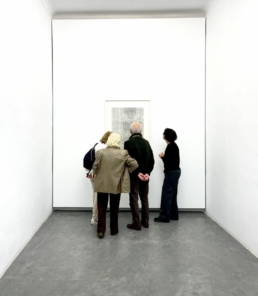
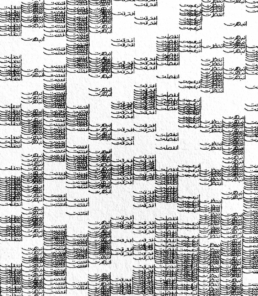
Plural, such was the qualification of the verb. It brings together distinct temporalities freed from the formal constraints and multiplied to give a quaternary sense for it. The verb becomes a state or a plastic expression in itself, in a performative kind. The word is put into action and reaches you by a gesture, sometimes repetitive, written or heard.
Like a life journey, Kossentini and Sellami were able to pursue what these words had to offer in the quest for ” the literary character of the text is inscribed on the side of the intentional object, in its noematic structure, one could say, and not only on the subjective side of the noetic act. “[3]
The process was interwoven with ante-Islamic poetry, which served as a breeze to tickle the artists’ senses to essentially extract an existence of its own from each verb. They began thus to think a language in movement.
Working with the spoken, rehearsed, mouthed, spelled language and at the same time intensified, as a material that mastered mainly the work by directing Nicene’s hand in her visual compositions and Alia’s breath to breathe her words.
In total harmony, both led the orchestra, they composed, sometimes taking over the reins by intuition, to the same degree of sensitivity and synchronicity.
Step by step, Kossentini and Sellami let themselves be guided by what the words made them undergo and communicate to them the matter of the plethora of possibilities in perceiving the reading journey of a word.
From a thought, they accessed the language through the sensory that led to a common root that could grow different branches, graphically and what it conveyed vocally as a meaning.
The sound is lived and sensed just like the written word, black on white, or what could be qualified as “the metaphysical exchange, the circular complicity of the metaphors of the eye and the ear. “[4]
Tumadhir’s walk is an exhibition that combines the mouvement of poetry, the essence of poetics, the sound and a meeting point of plastic and performative expressions that found their way through terms and vibratory means. The word becomes matter, a gesture, a life span and a musicality that has no limit to arouse the senses and to attain them.
Salma Kossemtini, Selma Feriani Gallery Tunis, November 2022
1. Derrida,J. (1992) Acts of litterature, Editions Routledge, p35
2. Derrida,J. (1972), Margins of philosophy, the University of Chicago, les editions de minuit, p1
3. Derrida,J. (1992) Acts of litterature, Editions Routledge, p4
4. Derrida,J. (1972), Margins of philosophy, the University of Chicago, les editions de minuit, p13
On a blade of grass - Fares Thabet
Curatorial
ON A BLADE OF GRASS - FARES THABET
13 DECEMBER 2021 - 5 FEBRUARY 2022
“Subtle nuances of a hue that progresses and spreads “[1] appear in the back- ground of his canvas, overlapped by a layer of colors that shape the appearance of the landscape sensed in Fares Thabet’s imagination. Semblances of forms emerge from his imagination, weathered materials lying at the threshold of his reality and his dreamscape. He sketches the outlines of his paintings in charcoal on the wall of his studio next to his blank canvas. He works his backgrounds first, studies his palette and looks for the vibration of his colors, one next to the other. Thabet places the locations of his flat surfaces often with strong luminous intensity and gradually adorns his paintings with details that mark his large land- scapes. His spaces evoke a familiarity and invite the audience to slip into his leafy world. He invokes miniatures that arise from Derek Walcott’s poems, from a light that stunned him on an early morning or from a stroll. As an extension of his reality, his paintings are conceived by brushstrokes soaked in paint, some dense and others less greasy. His touches of color define the limits of the surfaces, which occasionally blur, marking areas of impact or surface change. Each scene “develops and accentuates what is specifically precious in the things that give us daily pleasure”[2] , he treats painting as a purely sensory connection to the world he perceives. The colors like musical notes that he feels and that he does not necessarily manage to put into words but to perceive in form or vibration. “I paint for the sake of painting” he says.
The color works as an energetic detonation by its vibration and can still define a painting or his state of mind at the time of its conception.
Thabet bends in two to see, steps back, settles in his small terrace to paint. A landscape indoor or outdoor, is an open door to a pre-established experience that emerges from the material to the common world.
By tracing the fields, climbing the hills and stops at the seaside landscapes, the intra or extra-muros are scenes printed in his memory from his daily life or even postcards found in flea markets in downtown Tunis, “transformed into aesthetic substance”3. The color itself becomes matter and material of processing his daily life, working as a thread of narratives that he weaves between his paintings, with puzzled temporality; sometimes brightness of a pastel pink and other times darkness of an ultramarine blue. Thabet sought to escape the conceptual or politicized academism of the art schools he attended in Spain, in search of his own color, a slowness and a technique of his own. His return to Tunis, marked a turning point in his painting, he returned to seek an apprenticeship to follow a rhythm dictated to his artistic practice. “On a Blade of Grass” is the eulogy of the color, imagination and lucid dreams that arise from the world of Fares Thabet.
Salma Kossemtini, November 2021 Selma Feriani Gallery, Tunis
1. JHON DEWEY, translation coordinated by JEAN-PIERRE ,L’art comme experience,COMETTI, p84,2010
2. ibid , p42
3. ibid, p190
Aymen Mbarki - Open Studio
Curatorial
Drawing as an installation
Have you ever heard of a half human half bull creature that suffered its own fate? Have you ever heard of the fall of Babylon and the majesty of its empire that crumbled like thin pieces of paper in the glow of a fire? Have you ever heard of these myths that could possibly blend?
The lines were indeed their lingua franca, one which traced an endless road, with the tumultuous ends in which the minotaur lost its way and couldn’t trace it back.
It all unfolds from the seen and the unseen and as soon as you get deeper into the space, (and in depth) through layers of lines, spaces of possibilities that relate to one another start to emerge.
This is a key to taking a step in drawing as an installation. When the drawings become signs to guide you through, the narrating of a process that navigates in between fictional characters that will occur (show) through the layers of the acrylic brushstrokes or the thin black ink lines on old paper.
This open studio is the fruit of three-month residency of Aymen Mbarki; it is interwoven between drawings, gestures, classical music and numerous discussions around mythology which, (in fact,) though fictional, remains accurate and current to our realities.
